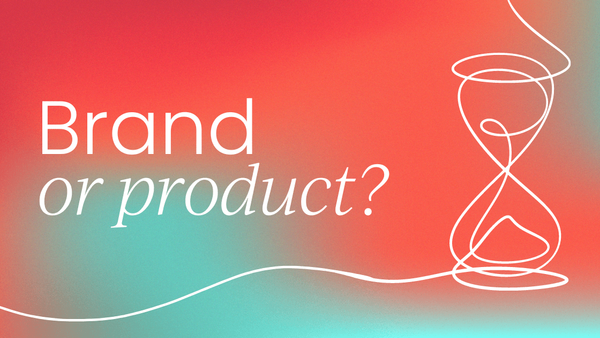Are you curious about the relationship between brands and products? If you answered yes, you're in the right place!
In marketing, there's a debate swirling over which comes first, the brand or the product. The truth is, there's a lot of nuance that makes this answer more complicated than simply choosing one or the other.
You need to understand products and brands and how they impact one another if you want to make good choices for your business and grow in meaningful ways.
Our goal today is to explore the dynamics between brand and product, offer actionable tips for building both, and show you how these elements work together to form a successful business.
On that note, let's get started!
Defining brand and product
Before we get any further into it, we are going to define both of the terms we will be discussing today. It's important to understand what they mean so we can compare, contrast, and elaborate.
What is a brand?
Visually, a brand is a logo, a catchy slogan, and an eye-catching color palette. But honestly, this is a really small part of what defines a brand.
A strong brand is the emotional connection customers have with a company. It's often rooted in their perception of its values, promises, quality, and experiences that make a business stand out from the competition and stick with prospects and customers long after they've seen the brand logo or made a purchase.
In my experience, the key to building a strong brand is consistency, authenticity, and fostering an emotional connection with the audience.
Want to know how this can pay off?
Consider this: research shows that 82% of people want brands to share their personal values. In other words, people are far more likely to care about your business if your brand identity resonates with their personal values and needs.

What is a product?
Product marketing represents the tangible or intangible items and services a company offers to meet customer needs. A product encompasses its features, benefits, and the overall experience people have when they use it.
It doesn't matter if you're selling software, golf clubs, or watches; the product is the core thing that a customer interacts with after they've made a purchase.
However, a product is not just about function; it's about delivering a solution in a way that exceeds customer expectations, both in product design and post-sale support. Effective customer segmentation allows companies to tailor products and services to specific groups, enhancing the overall experience for each segment.
For example, 82% of consumers are willing to spend more money on a product if they consistently receive excellent service, which I believe highlights the importance of the overall product experience, not just the physical item.
The connection between brand and product
Put plainly, the relationship between the product and brand is symbiotic. A strong product can enhance brand perception, just as a strong brand can create anticipation and trust around new products.
If you want to grow your business and increase sales, you need to come to terms with this fact so you can start thinking about how to bring these two elements together in your sales process. Otherwise, you risk disjointed marketing messages and diluting your brand equity.
So, this brings us back to our original question: which comes first?
Let's explore both approaches: building a brand-driven product versus creating a product-driven brand.
Building a brand-driven product
The benefits of starting with a strong brand
Starting with a strong brand identity before developing a product offers several advantages you should know about.
For one thing, a well-established brand acts as a framework for your products, whether it's designing something new or updating something that already exists. If you understand your brand's core values and promises, as well as what your customers expect, you can create something that people will love.
It's worth mentioning that this alignment helps to maintain a consistent experience, which is crucial for building trust and loyalty. You want people to have the same positive experience the second, fifth, and tenth time they buy something from your site.
A recognizable brand can also create anticipation for new products. For instance, when Apple announces a new product, consumers are already excited and ready to purchase because they are deeply invested in this brand. There's no question that their brand equity provides a competitive advantage over everyone else on the market.
Beyond the face value benefit, there's also the fact that this reduces the time and cost needed to build brand awareness and demand for new products.

Examples of brand-driven products
Nike is a prime example of a company that successfully builds products based on a strong brand.
The "Just Do It" slogan drives the development of every product they put on the market. It cleanly aligns with Nike's values of performance, empowerment, and innovation, which means when people see an instantly recognizable swoosh, these feelings come to mind.
Since people trust Nike's brand, this trust carries over to its products, from footwear to athletic gear and everything in between.
Practical tips for building a brand-driven product
- Define your brand's core values: Start by clearly articulating the core values that your brand stands for. These values should be the foundation for every product you create.
Ask yourself: Does this product reflect the brand's mission? Does it align with our customer's expectations? If the answer is no, the product you have in mind needs some tweaks or simply isn't right for your business. - Create consistent messaging across all channels: Consistency is key to brand strength. Make sure your messaging is memorable and consistent across all platforms, from social media to packaging, so that people learn to recognize your voice and tone when they encounter your brand.
Tip: The right choices of tools will help you with streamlining your brand management process and reaching the right audience, for example, content distribution software to efficiently spread your messaging, brand monitoring tools to track brand mentions and relevant keywords, or reputation management platforms to address negative publicity or online crises. - Use brand equity to launch new products: Once you've established your brand identity, use it to generate excitement around new products. I suggest communicating how the new product fits within the brand's existing narrative and reinforces your values. You can see an example of this in the image from Nike above.
- Ask for feedback: Often, your customers can help guide your products so they line up with your brand. I suggest sending our surveys through email, conducting polls on social media, and asking existing customers for their thoughts on new products. Read through their feedback and see if people think you're being true to your brand. Since you can't have a business without customers, their feedback is vital throughout this process.
- Focus on emotional connection: Finally, cultivate an emotional connection between your brand and your customers. You can do this by sharing stories and finding opportunities to chat with your audience, such as by hosting an Ask Me Anything event on social media after a product reveal. This experience will help people connect with your brand, which means they are more likely to buy your product.
Creating a product-driven brand
Let's flip things around now and discuss how you build a brand based on the product or products you're selling.
The advantages of starting with a unique product
A high-quality product can also serve as the foundation for building a recognizable brand.
What's interesting is how a product can actually establish your brand's identity through its unique features, benefits, and functionality.
Unique, high-value products create an immediate market presence and can help you stand out from everyone else, even well-known brands that have been doing this for way longer than you have.
With this in mind, a well-executed product-first approach allows you to focus on perfecting the customer experience around that product, building a brand identity organically from the product's success.
One of the ways this is possible is through user reviews.
When you consider that 88% of people trust reviews over advertising, it's easy to see how positive reviews can quickly stack up and build a brand's reputation, even if they were relatively unknown up until that point.
Examples of product-driven brands
Dyson, a company that's well-known for vacuums and other cleaning products, is an excellent example of a product-driven brand.
When James Dyson introduced his innovative vacuum cleaner in 1993, the product itself drove the brand's identity. People didn't know much about this company, but they were intrigued by the promise of a vacuum cleaner that was superior to everything else on the market.
Fast forward to today, and Dyson is a household name associated with innovation, reliability, and high-quality products. The brand's strength grew directly out of the product's success.
Practical tips for creating a product-driven brand
- Prioritize product innovation: Focus on creating a product that stands out in the market. Innovation should be at the top of your mind. Think of ways you can offer something truly unique that aligns with the goals, needs, and pain points of your target audience.
- Invite customers to leave reviews: Social proof is a driving force for businesses across all industries. People are more likely to buy a product if they see that other people did and had a positive experience.
With this in mind, I suggest encouraging satisfied customers to share their experiences. You can then share their feedback on your homepage and product pages. Below is an example of how reviews can shape the way people see a brand. - Develop a clear product story: If you want to win people over with your product alone, you need a good story around it. Explain why it exists, how it was developed, and what makes it different.
This story will help establish why your product is important and, over time, will help to form the foundation of your brand. There are several ways to bring your story to life and connect with your audience on a deeper level, for example, a product video that tells its unique journey, or an interactive experience through VR demo. - Align future products with the original identity: As you expand your product line, make sure your new products align with the value and identity that attracted people to your first product. Consistency in product quality and experience will solidify your brand in the minds of consumers.
- Stay focused on customer experience: Finally, a strong product-driven brand doesn't just stop at innovation. By consistently delivering a top-notch customer experience, from purchase to post-use, you reinforce your brand's promise and build confidence with your audience.
Final thoughts: Which comes first?
When it comes down to it, the decision to start with a brand or a product ultimately depends on your circumstances.
For some, building a strong brand foundation provides the clarity needed to develop products that resonate with their audience.
For others, an innovative product can carve out a space in the market and become the cornerstone of a brand's identity.
Ideally, you should build your brand and product simultaneously so you can be sure they're both perfectly aligned from the start. However, I know this isn't always possible.
So, whether you choose to focus on a brand-first or product-first approach, remember that success comes from being patient, persistent, and passionate. Take the time to understand your market, your customers, and how your brand and product can work together to create a memorable experience.
Now, take some time to reflect on your own experiences. Are you starting with a brand, a product, or both? How can you apply the concepts discussed in this article to your marketing strategy? The choice you make today will shape the future of your business.


















 Follow us on LinkedIn
Follow us on LinkedIn






.svg)
Start the conversation
Become a member of Product Marketing Alliance to start commenting.
Sign up now